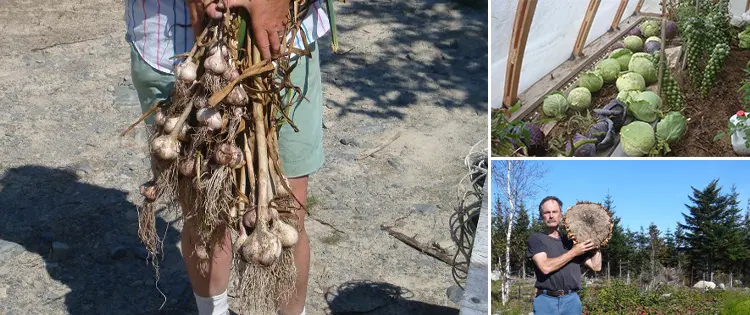Is raising 100% of your own vegetables possible? Absolutely. We raise 100% of our vegetables which means we don’t rely on the grocery store for any of our veggies regardless of the time of the year. This was particularly relevant when we lived remote in the bush of northern Saskatchewan where our homestead was only accessible via bush plane. We flew to town twice a year and it was only during those biannual trips to civilization that we did any shopping. Being self-reliant was a necessity.
Even though we are more accessible to stores now, we still grow all of our vegetables.
This takes some effort on our part as well as proper planning. The first step to vegetable independence is figuring out how much to plant to meet your needs. For first time gardeners, this may be difficult. But if you approach the problem logically, it’s not as daunting as it seems. First determine what your likes and dislikes are (no need to plant cabbage if no one will eat it) then determine how much of each item you consume in the run of a year. The easiest way to approach that is to think about how much of any given item you eat in a week or month then extrapolate from there.
We categorize the vegetables we grow into 3 groups based on our like and dislikes: the staples, our favorites and finally the minor vegetables. For us, the staple vegetables are potatoes, carrots, cabbages, onions, tomatoes and dry beans. We grow a lot of each of these as they are very versatile. Each can be used in so many different ways as you’ll see below. If we could only grow a limited number of vegetables these would be the ones we’d choose.
Our favorite vegetables include peas, corn, broccoli, lettuce, spinach, green and wax beans, celery, leeks, peppers, summer and winter squash, pumpkins, garlic and peppers. We grow large quantities of these too and they comprise a significant portion of our diet. We’d be hard pressed to decide which of these to reduce production of or eliminate altogether.
For us, the minor vegetables include Brussels sprouts, cauliflower, parsnips, cucumbers, eggplant, kale, escarole, radish and Witloof chicory. We don’t grow vast quantities of any of these and in fact some years we may not grow some of these at all. In reality if we had to limit what we grew for some reason these would be the first we’d eliminate. We like them in small doses but we wouldn’t necessarily miss them if we didn’t grow them. It is nice to have small amounts of these though to add more variety to our diet especially to our winter menus.
Below is a synopsis of what we grow, how much we plant and how we use each item. Understand this is based on our household of 2, what our food preferences are as stated above as well as our desire to be completely self reliant when it comes to our vegetables. Be aware in some instances we’ve given the feet of row we grow. This does NOT mean you have to plant a single row that length. Many items can be grown in beds with rows spaced as close as 6 inches apart. In this instance you would add up the length of several rows to reach the total length being grown.
Vegetable Amount We Plant How We Use It Average Harvest Beans, snap (wax and green) 8 to 10’ of row of each Cooked as a side dish, in soups, canned in pickled 3 bean salad. Frozen for winter use 5# per 4’; 20 pods per plant Beans, shell (Lima etc.) 60 to 90 foot row Cooked as a side dish, in soups, in succotash, canned in 3 bean salad. Frozen and canned for winter use 2½# shelled beans per 10’ row Beans, dry(kidney, Yellow Eye, Jacobs Cattle, black beans etc) 100 foot row of each kind in any given year In soups, chili, in homemade baked beans, in re-fried beans 1# dry beans per 10’ row Beets 12 to 16’ row Canned pickled beets 1# per foot Broccoli 12 to 15 plants for spring planting, 6 to 10 for fall planting Raw in various salads, steamed, broccoli cheese soup, chicken divan. Frozen for winter use 4# to 6# per 10’ row Brussels sprouts 6 to 8 plants Steamed as side dish, roasted 60 or more sprouts per stalk Cauliflower 3 to 4 plants Raw in various salads or with dip 9 oz. to 30 oz. Per head Cabbage, early 4 to 5 plants Raw in various coleslaws and salads, cooked as side dish, preserved as freezer slaw for winter salads 2# to 3# per head Cabbage, late(for storage) 12 plants, more if I plan to make sauerkraut Raw in various coleslaws and salads such as cabbage Waldorf salad, sauerkraut, sauteed & baked as side dishes, in various soups such as cabbage sausage soup, New England boiled dinner Celery 24 to 30 plants Raw in various salads, in soups, stuffing and in many items I can such as vegetable juice, stewed tomatoes and spaghetti sauce, vegetable and meat stocks. Frozen for winter use in cooking 1# per plant Carrots 50 feet of row Raw in salads and coleslaw, cooked side dishes, in soups, stews, pot roasts, casseroles, roasted with other vegetables, vegetable and meat stocks. The king of root cellar storage(stores for as long as 8 months) 1# per foot of row Corn 200 to 240 stalks or plants Corn on the cob, frozen for use in soups, corn chowder, succotash, casseroles, cooked side dishes such as Mexican corn and zucchini with corn Cucumbers 2 to 3 hills with 3 to 4 plants each Raw with dip, in salads, refrigerator dill and bread and butter pickles, dill relish, sweet relish 10, 6 oz. Cucumbers per plant Eggplant 2 plants Dipped in seasoned bread crumbs and pan fried, parmigiana 2 to 4 eggplants/ plant weighing 1# to 2# each Endive/escarole 3 to 4 plants Raw in winter salads 4# per 10’ row Kale 16 feet of row Frozen for winter use in soups 4# per 10’ row Leeks 24 plants Potato leek soup and other soups, baked chicken with leeks, potato casseroles such as scalloped potatoes 1½# per foot of row Lettuce Leaf 15 plants, Bibb 6 to 12 plants, Romaine 6 to 12 plants, Head 6 to 8 plants In various wraps and sandwiches including BLT’s. Taco salad, chef salad, Caesar salad, tossed salad 1 head per plant of 10 oz. to 1# each Onions 5 lbs yellow onion sets,½ lb red sets, 50 to 60 spanish onions grown from seeds In everything but desserts. Soups including onion soup, entrees, casseroles, in side dishes, stuffing, vegetable stock and meat stocks, fried onion rings, roasted with other vegetables, raw in salads and sandwiches, pizza topping. Goes in many items I can such as vegetables juice, stewed tomatoes, spaghetti, taco sauce, Bar-B-Que sauce. Properly cured onions will keep 8 months 5# bulbs per 6’ of row Onions, green 12 to 16 feet of row Raw in various salads Onions, pickling type 24 to 32 feet of row Used to can pickled onions Parsnips 8 to 12 feet of row Roasted with other vegetables 1# per foot of row Peas, green Early variety-double row 20’ long Late variety-double row 25’ long Cooked as side dish, in various soups, raw in salads. Peas freeze beautifully and are a favorite frozen veggie for winter use 2# to 6# per 10’ of row Peas, snow Double row 5’ long Sauteed as side dish, various stir fries, in salads Peas, edible pod Double row 4’ long Cooked as side dish and in salads Peppers (hot) 6 to 12 plants Canned as pickled hot peppers, used to make hot sauce, Bar-B-Que sauce and ketchup 6 to 8 fruits per plant Peppers (bell) 15 to 20 plants Raw with dip and in various salads, in sandwiches and wraps, in stir fries, in grilled vegetables, stuffed, pizza topping. Strips are frozen for use in soups, casseroles and entrees such as Swiss steak, fajitas and pepper steak 3# to 4# per plant (6 to 10 fruits per plant) Potato 3 rows about 75’ long-a row each of russet, Yukon gold and a red variety In many soups such as chili potato soup, chowders, casseroles such as scalloped potatoes and au gratin potatoes, baked, twice baked, roasted, baked potato wedges, herb roasted, boiled, mashed, fries, home fries, stews, pot roasts and even in breads such as potato rolls. Stores for 7-8 months in root cellar Up to 5# per plant Pumpkin 2 to 4 hills with 3 to 4 plants each Various breads, muffins, cakes, pie. Properly cured stores for months 2 to 5 fruits per plant weighing 6# to 20# each depending on variety Radish, summer Intercrop with carrots and parsnips Raw in salads or with dip 2# to 3# per 10’ Radish, winter 3 to 4’ of row Raw in winter salads Up to 20# per 10’ Squash, summer 1 hill zucchini with 3 to 4 seeds 1 hill yellow crookneck with 3 to 4 seeds Sauteed, grilled with other veggies, in stir fries, in soups, roasted, zucchini pancakes, in baked good such as zucchini bread, lemon zucchini muffins and zucchini chocolate cake. In entrees such as Mix and Match squash casserole and Stuffed zucchini Squash, winter 3 to 4 hills with 3 to 4 seeds each Orange glazed squash, Maple glazed squash, Stuffed with apples, cranberries and raisins, baked with brown sugar and butter, casserole with praline topping. Properly cured stores for months Tomatoes, cherry 3 to 4 plants Raw in salads, in sandwiches and wraps Tomatoes, early slicers 8 to 12 plants but could be as many as 20 plants Raw in salads, sandwiches such as BLT’s and, in canning vegetable juice and tomato soup. Marinated tomatoes, Italian baked tomatoes, Sesame cheese tomatoes, scalloped tomatoes, Italian herbed tomatoes, fresh tomato soup Tomatoes, Beefsteak type At least 12 plants As above Tomatoes, paste type 24 plants Roasted. Used in canning plain sauce, spaghetti sauce, taco sauce, ketchup, Bar-B-Que sauce, stewed tomatoes and plain cut up tomatoes Garlic 80 to 90 cloves In salad dressings, as a pizza topping, Italian dishes such a spaghetti sauce, in entrees such as Maple glazed pork tenderloin, in meatballs, in mashed potatoes, in soups such as Minestrone & Italian chicken, baked cabbage Witloof chicory (Belgian endive) 8 feet of row Raw in winter salads Spinach 50 feet of row for spring. Fall wherever I have space Raw in salads such as spinach orange salad, cooked side dish, in pasta dishes such as spinach manicotti/lasagna and noodles florentine, in various soups, chicken florentine ½# per foot
Vegetable independence doesn’t magically happen. But with some planning and effort you too can be on your way to freedom from supermarket produce. Good luck and happy gardening!
You may also like:
Best Crops For Your Survival Garden
The Succulent Red Plant That Tastes Like Bacon (Video)
10 Common Mistakes You Should Avoid If You Want To Raise Chickens
Ingenious Ways To Use Toilet Paper Rolls That You Never Thought Of










Great article. Thank you Ron. I also have your book!
Thank you Robert. Just came across your comment. Sorry I didn’t see it sooner and thanks so much for your support. Glad you found our article useful. Take good care!
This is WONDERFUL information. A much-needed example for many people as a goal to aim for. Thank you so much!!